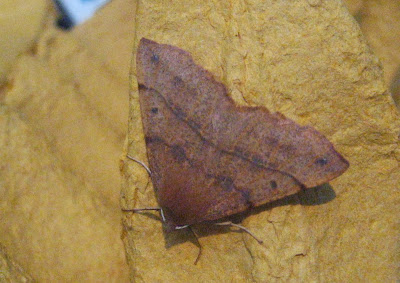 |
| Quelle vue de notre fenetre, alors! It doesn't actually lean. That was me. |
The moths have been left undisturbed for three full nights, the last of which saw us at the outer tip of St Jude's Day's reasonably great storm. Luckily this left no trace here beyond a larger number of leaves tumbling than usual and the trap would probably have survived intact, had I put it out.
 |
City of romance
- so what's the
story here? |
So it hasn't been the weather behind my long weekend. Non! C'etait a cose de notre premiere visite a Paris avec l'Eurostar. We hooked up with our pals Sarah and Greg Meredith, she the
painter extraordinaire who kindly comments here from time to time, and Greg a master of intricate law and wit.
Il n'y a pas de moths a Paris; indeed, even when I Googled 'moth' and 'Paris' in advance, the best I came up with was a Tripadvisor blast at a restaurant where a moth had been found in the salad (a five star recommendation so far as I am concerned. Appropriately, the notion of us eating a moth was stood on its head at the Bateau Mouche station where the floating quay has this spooky sculpture of butterflies finishing off a tasty skull.
Back home, amid the swirls of wind and rain, the ace interior moth-spotter Penny discovered this Copper Underwing sadly dead beside a windowsill potted plant. Sadly for the moth, but happily for me, because it allowed a chance to see if it was a straightforward Copper Underwing or the slightly less common but almost identical Svensson's Copper Underwing.
As with similar 'doubles' such as the Common and Lesser Common Rustic and the Marbled and Dark Marbled Carpet, incontrovertible distinction usually means doing queasy things like anaesthetising the moth with ether or half-freezing it in the fridge and then checking out tricky detail such as claspers for holding on to female moths during sex. A dead moth conveniently allows us to avoid such measures, although rigor mortis can make wing pattern checks a challenge.
One of the differences between the two Copper Underwing species is the patterning on the underside of the underwing - again, usually very difficult to suss on a live moth because these two are among the jumpiest of all the UK species. Here's the pattern on my ex-moth, below, and Richard Lewington's paintings of the two different wing patterns from
the Moth Bible.
Here's Svensson, first
And then, below, the standard Copper Underwing followed by a closer look at the real thing on my moth. My exciting orangey red arrow shows the black mark which establishes that this is not a Svensson's. Now to await any dissenting Commentor, but I hope that I'm right.

















































